I wanted to learn how to anodize aluminum but the only dyes I could get a hold of on short notice were RIT dyes.
To anodize I needed a tank of sulfuric acid / water mixed. With my setup I was using a 5 gallon bucket with a 14:1 water to sulfuric acid ratio. Sulfuric acid is nasty stuff and you always add your acid to the water, never pour water into acid. I used some of the battery acid refills from an auto parts store which are about 33% sulfuric acid as my acid source and added it to about 2 gallons of water. I kept the quantities low as I am working with small parts and it helps prevent any acid mix from splashing over the sides of the bucket. If I need to do larger parts I’ll add some more. It’s also good to keep a lot of baking soda around to neutralize any acid spills in case of an accident.
I did the math wrong so the bucket is labeled 8:1 but it’s 14:1. I’ll be fixing that shortly by adding more acid. I also filled a bucket halfway with plain water for rinsing the acid off the parts once they were done anodizing. If you’re doing production work or anything beyond a test you might want to use distilled water. Tap water of poor condition can cause defects in the anodizing, dying and sealing processes.
Click the photos to enlarge them.
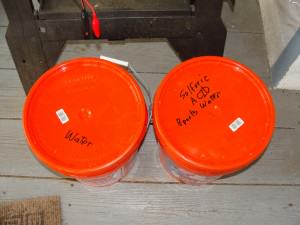 I also needed an anodizing power supply. I started off with a 3 Amp 13.8 Volt power supply I had sitting around. At this current it took around 90 minutes to anodize these smaller pieces. I think the conductivity of the anodizing bath varies with acid content and with my mixture the current draw stayed relatively low. With my 14:1 sulfuric acid mix the 3 amp power supply didn’t overheat at all. I connected a 30 amp 12 volt power supply later, but due to the built in current limiting of the sulfuric acid mix it still took about 90 minutes. If I was running a 6:1 mixture water:acid ratio like some recommend I’m sure the process would be much faster. The Caswell small anodizing system specs out a 4.5 amp power supply with a 11:1 water:acid ratio.
I also needed an anodizing power supply. I started off with a 3 Amp 13.8 Volt power supply I had sitting around. At this current it took around 90 minutes to anodize these smaller pieces. I think the conductivity of the anodizing bath varies with acid content and with my mixture the current draw stayed relatively low. With my 14:1 sulfuric acid mix the 3 amp power supply didn’t overheat at all. I connected a 30 amp 12 volt power supply later, but due to the built in current limiting of the sulfuric acid mix it still took about 90 minutes. If I was running a 6:1 mixture water:acid ratio like some recommend I’m sure the process would be much faster. The Caswell small anodizing system specs out a 4.5 amp power supply with a 11:1 water:acid ratio.
And of course I needed some protection. I didn’t want to be messing around with acid baths and other stuff without some safety gear. I used some full surrounding goggles and some rubber gloves that go up to the mid forearm. If you want to be really protected a full face shield would be a great idea, as well as a rubber apron.
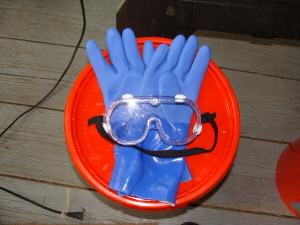 The first piece I decided to photograph the anodizing process on is a small tap leveler my friend Ollie made for me. It basically sits flat against a surface and keeps your tap square as you feed it into a hole in the surface. He made this for me back when I was tapping the holes for my CNC router’s linear rails and it made a world of difference. I cleaned up the piece and polished it but I didn’t sand it down to a mirror smooth finish or anything like that. To degrease I washed it in acetone and then rubbed it down in isopropyl alcohol (rubbing alcohol).
The first piece I decided to photograph the anodizing process on is a small tap leveler my friend Ollie made for me. It basically sits flat against a surface and keeps your tap square as you feed it into a hole in the surface. He made this for me back when I was tapping the holes for my CNC router’s linear rails and it made a world of difference. I cleaned up the piece and polished it but I didn’t sand it down to a mirror smooth finish or anything like that. To degrease I washed it in acetone and then rubbed it down in isopropyl alcohol (rubbing alcohol).
I stuff some aluminum wire into the end. You need really good contact of your wire to the piece you’re anodizing or the wire could anodize and you’ll loose electrical contact and your part won’t anodize. I bent the wire on itself a few times until it was too big to fit into the hole by just a bit and then drove it into the hole with a drift and hammer.
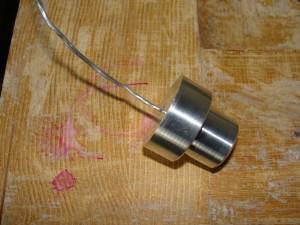 I then attached a piece of scrap aluminum to the negative post of the power supply and connected the work object to the positive side of the power supply. This is anodizing after all, and the positive side is considered the anode, the negative side the cathode. I dipped the piece in the tank and let it run for about 90 minutes. You can actually over-anodize and at a certain point the anodized layer will start being removed from the surface. If you have an ammeter on your power supply you can watch for the current to reach it’s lowest point during anodizing.
I then attached a piece of scrap aluminum to the negative post of the power supply and connected the work object to the positive side of the power supply. This is anodizing after all, and the positive side is considered the anode, the negative side the cathode. I dipped the piece in the tank and let it run for about 90 minutes. You can actually over-anodize and at a certain point the anodized layer will start being removed from the surface. If you have an ammeter on your power supply you can watch for the current to reach it’s lowest point during anodizing.
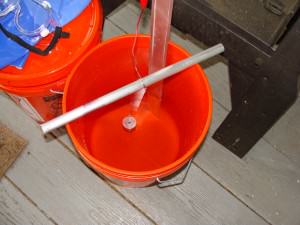 When the part was nearing the 90 minute mark I decided to mix up some dye. I had tried some liquid RIT dyes but I also bought a powdered RIT dye in Sunshine Orange that I wanted to try. I mixed the dye up in a small container and then heated it. Most places I read say the dye has to be at around 120-140 degrees (F). The RIT dyes must contain some kind of metal in them because the dark blue, red and orange dyes I have all sparked/arced in the microwave. I ended up heating them in a bath of very hot water till they reached the proper temperature.
When the part was nearing the 90 minute mark I decided to mix up some dye. I had tried some liquid RIT dyes but I also bought a powdered RIT dye in Sunshine Orange that I wanted to try. I mixed the dye up in a small container and then heated it. Most places I read say the dye has to be at around 120-140 degrees (F). The RIT dyes must contain some kind of metal in them because the dark blue, red and orange dyes I have all sparked/arced in the microwave. I ended up heating them in a bath of very hot water till they reached the proper temperature.
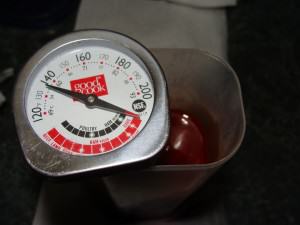 After turning off the power supply I pulled the piece from the acid tank and rinsed it off very well in the water tank, then dipped it immediately into the dye for about 15 minutes. After 15 minutes it had sucked up all the dye that it was going to but it looked a bit more yellow than orange. I suspect if the anodizing layer had been thicker that the coloration would be darker. Still, RIT dyes aren’t the best for doing anodizing work, but are passable. The yellow was actually quite nice looking though.
After turning off the power supply I pulled the piece from the acid tank and rinsed it off very well in the water tank, then dipped it immediately into the dye for about 15 minutes. After 15 minutes it had sucked up all the dye that it was going to but it looked a bit more yellow than orange. I suspect if the anodizing layer had been thicker that the coloration would be darker. Still, RIT dyes aren’t the best for doing anodizing work, but are passable. The yellow was actually quite nice looking though.
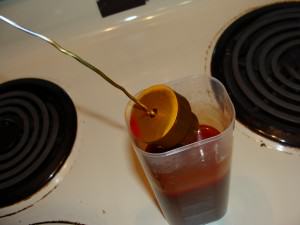 Once the part is dyed you’re supposed to seal it. This is done either by boiling the part or using an anodizing sealant like nickle acetate. I went for the cheap method which was boiling for about 15 minutes. This seemed to work well and the part held the dye well, as well.
Once the part is dyed you’re supposed to seal it. This is done either by boiling the part or using an anodizing sealant like nickle acetate. I went for the cheap method which was boiling for about 15 minutes. This seemed to work well and the part held the dye well, as well.
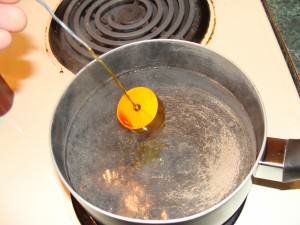 The resulting part came out alright. Yellow, not orange, but it looks pretty nice. You can see the result photos below which show the anodized part dyed in the RIT dye and sealed in boiling water resulting in a nice matter finish.
The resulting part came out alright. Yellow, not orange, but it looks pretty nice. You can see the result photos below which show the anodized part dyed in the RIT dye and sealed in boiling water resulting in a nice matter finish.
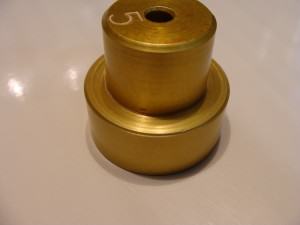 I wanted to try anodizing something really shiny so I took the tail fin that I machined for my Mini-Titan 450 helicopter out of mirror finishes aluminum stock and anodized that. You can see the quality of the surface in the picture below.
I wanted to try anodizing something really shiny so I took the tail fin that I machined for my Mini-Titan 450 helicopter out of mirror finishes aluminum stock and anodized that. You can see the quality of the surface in the picture below.
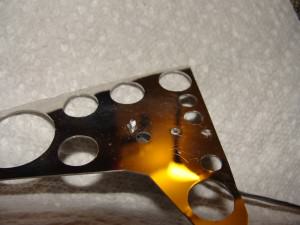 I decided to use the liquid RIT red dye this time. I had to heat it up in a bath of almost boiling hot water to get it up to temperature and that made some pretty interesting designs due to the convection in the dye tank as it heated up.
I decided to use the liquid RIT red dye this time. I had to heat it up in a bath of almost boiling hot water to get it up to temperature and that made some pretty interesting designs due to the convection in the dye tank as it heated up.
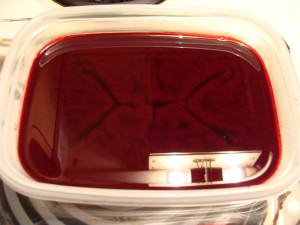 The same process again, throw the anodized part into the dye tank for 15 minutes thenwait patiently for the color to settle in. Here’s the before picture of the part after anodizing. You can already see that it’s lost that mirror finish polish on it and now looks quite a bit more matte.
The same process again, throw the anodized part into the dye tank for 15 minutes thenwait patiently for the color to settle in. Here’s the before picture of the part after anodizing. You can already see that it’s lost that mirror finish polish on it and now looks quite a bit more matte.
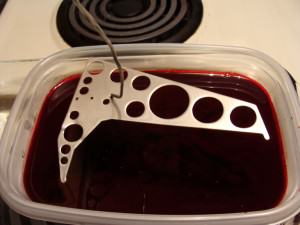 The photo of the part after sitting in the red RIT dye for 15 minutes. The fin took the color on very well, but not as well as another piece I had anodized earlier in the week. The piece may have been over-anodized or not anodized deep enough. I’m still in the ‘just screwing around’ phase of anodizing so I’ve not got everything down to a scientific method, yet.
The photo of the part after sitting in the red RIT dye for 15 minutes. The fin took the color on very well, but not as well as another piece I had anodized earlier in the week. The piece may have been over-anodized or not anodized deep enough. I’m still in the ‘just screwing around’ phase of anodizing so I’ve not got everything down to a scientific method, yet.
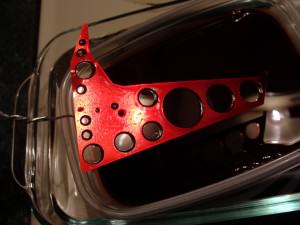 Here’s the anodized helicopter tail fin after some polishing.
Here’s the anodized helicopter tail fin after some polishing.
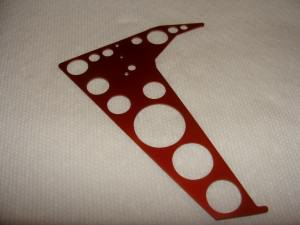 You can see that the color is not as deep as a piece of scrap aluminum (carpet threshold) that I did earlier, but it’s still pretty nice looking overall for one of my first few tries.
You can see that the color is not as deep as a piece of scrap aluminum (carpet threshold) that I did earlier, but it’s still pretty nice looking overall for one of my first few tries.
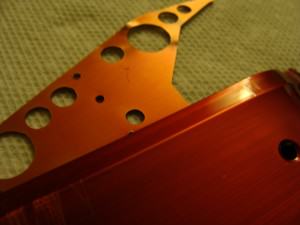 The final few pictures are just of the few parts I’ve anodized. I also did the new revision of my aluminum Mini-Titan tail fin in what was supposed to be some kind of blue, but it turned out more purple. I’m going to machine another couple of them this week to try with the real anodizing dyes once I can afford to put an order in from Caswell.
The final few pictures are just of the few parts I’ve anodized. I also did the new revision of my aluminum Mini-Titan tail fin in what was supposed to be some kind of blue, but it turned out more purple. I’m going to machine another couple of them this week to try with the real anodizing dyes once I can afford to put an order in from Caswell.

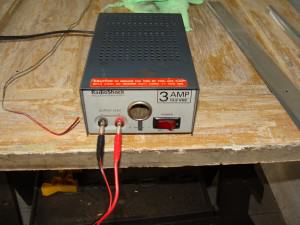
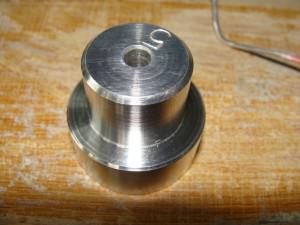
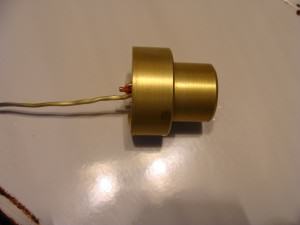
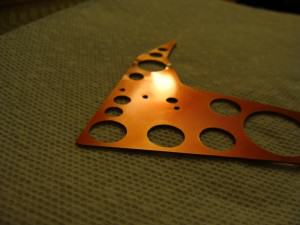
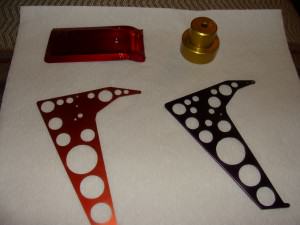
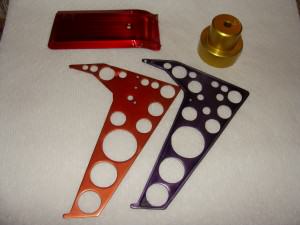
2 responses to Anodizing Aluminum with Rit Dye
That looks pretty good – the comments I have seen elsewhere talk about the RIT not being UV resistant, and the dye fades.
I guess you roll the dice with what color your part goes into and what color it becomes n its way out of the process.
Yeah, the Caswell dyes are expensive, and the shipping is as much as the material for small orders.
Still, I guess I will try with Caswell.
wow. turned out a lot better than I expected. kudos.
Leave a reply to Anodizing Aluminum with Rit Dye